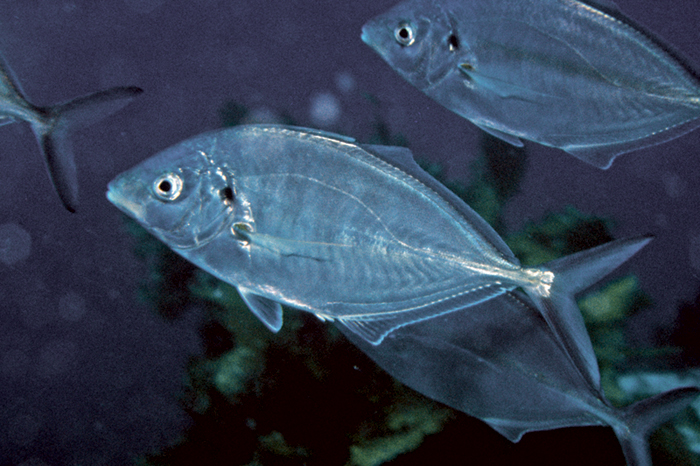Skipjack Trevally, Pseudocaranx wrighti (Whitley 1931)
Other Names: Sand Trevally, Silver Trevally

Skipjack Trevally, Pseudocaranx wrighti. Source: Rudie H. Kuiter / Aquatic Photographics. License: All rights reserved
Summary:
A steely-blue trevally with a small well-defined solid black spot on the upper margin of the gill cover that is approximately pupil diameter, transparent or dusky green second dorsal and anal fins (never with yellow pigmentation), and no yellow mid-lateral body stripe. Juveniles have narrow grey bands along the sides.The rear margin of the upper jaw slopes posteroventrally.
Cite this page as:
Bray, D.J. 2021, Pseudocaranx wrighti in Fishes of Australia, accessed 17 Apr 2025, https://fishesofaustralia.net.au/home/species/4280
Skipjack Trevally, Pseudocaranx wrighti (Whitley 1931)
More Info
|
Distribution |
Endemic to southern Australia, from southern New South Wales and Bass Strait, Victoria, to the Rottnest Island area, with a record from Exmouth Gulf, Western Australia. |
|
Features |
Dorsal fin VIII + I, 22-26; Anal fin III, 20-22; Caudal fin 17; Pectoral fin 17-19; Pelvic fion I, 5; Lateral-line scales 44-58 scales + 16-25 scutes; Gill rakers 11-14 + 24-28. Posterior margin of upper jaw canted posteroventrally; lachrymal and expanded part of maxilla densely covered with scales; caudal vertebra 14; gill rakers 10–15 upper, 24–28 lower, 35–43 total; scales in curved part of lateral line 37–48. |
|
Size |
This is the smallest smallest species of Pseudocaranx, rarely exceeding 200 mm FL. |
|
Colour |
Steely blue, silvery below, with discrete small black spot on upper margin of opercule; juveniles with narrow grey bands on sides but without a mid-lateral yellow stripe. |
|
Fisheries |
Juveniles usually occur in large schools and are often taken in considerable numbers by prawn trawlers working along the South Australian coast. |
|
Similar Species |
This species has long been confused with the widespread Silver Trevally, Pseudocaranx georgianus, which it closely resembles. |
|
Species Citation |
Usacaranx georgianus wrighti Whitley 1931, Aust. Zool. 6(4): 317. Type locality: Kingston, South Australia. |
|
Author |
Bray, D.J. 2021 |
|
Resources |
Skipjack Trevally, Pseudocaranx wrighti (Whitley 1931)
References
Bearham, D., Robert, M., Chaplin, J.A., Moore, G.I., Fairclough, D.V. & Bertram, A. 2019. Molecular evidence of three species in the Pseudocaranx dentex complex (Carangidae) in Australian waters. Marine and Freshwater Research: https://doi.org/10.1071/MF18445
Gomon, M.F. 1994. Family Carangidae. pp. 582-590 figs 516-522 in Gomon, M.F., Glover, C.J.M. & Kuiter, R.H. (eds) The Fishes of Australia's South Coast. Adelaide : State Printer 992 pp. 810 figs.
Hutchins, J.B. & Swainston, R. 1986. Sea Fishes of Southern Australia. Complete field guide for anglers and divers. Perth : Swainston Publishing 180 pp.
Hutchins, J.B. & Thompson, M. 1983. The Marine and Estuarine Fishes of South-western Australia. Perth : Western Australian Museum 103 pp. 345 figs.
Kuiter, R.H. 1993. Coastal Fishes of South-eastern Australia. Bathurst : Crawford House Press 437 pp.
May, J.L. & Maxwell, J.G.H. 1986. Field Guide to Trawl Fish from Temperate Waters of Australia. Hobart : CSIRO Division of Marine Research 492 pp.
Smith-Vaniz, W.F. 2008. Family Carangidae. pp. 575-581 in Gomon, M.F., Bray, D.J. & Kuiter, R.H. (eds) Fishes of Australia's Southern Coast. Sydney : Reed New Holland 928 pp.
Smith-Vaniz, W.F., Carpenter, K.E., Matsuura, K., Motomura, H. & Larson, H. 2018. Pseudocaranx wrighti . The IUCN Red List of Threatened Species 2018: e.T20433543A67871585. https://dx.doi.org/10.2305/IUCN.UK.2018-2.RLTS.T20433543A67871585.en. Downloaded on 29 January 2020.
Smith-Vaniz, W.F. & Jelks, H.L. 2006. Australian trevallies of the genus Pseudocaranx (Teleostei: Carangidae), with description of a new species from Western Australia. Memoirs of Museum Victoria 63(1): 97-106 http://doi.org/10.24199/j.mmv.2006.63.12
Whitley, G.P. 1931. New names for Australian fishes. The Australian Zoologist 6(4): 310-334 1 fig. pls 25-27
Yearsley, G.K., Last, P.R. & Ward, R.D. (eds) 1999. Australian Seafood Handbook. Hobart : CSIRO Marine Research 460 pp.


